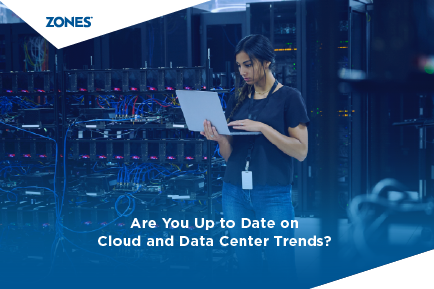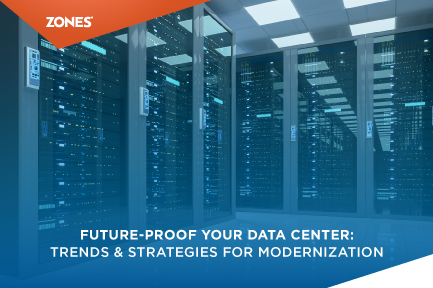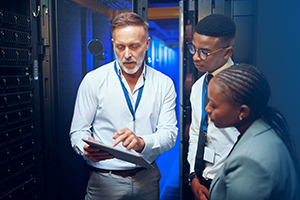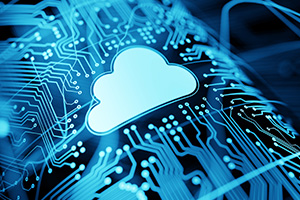Navigating the Future of Data Centers: Trends and Modernization Strategies
The data center is now the foundation to modern IT infrastructure since companies are depending more and more on digital solutions to spur growth....
3 min read
![]() Zones
:
Aug 22, 2025 10:00:00 AM
Zones
:
Aug 22, 2025 10:00:00 AM

Data, data, and more data. As businesses integrate AI tools, run on advanced software, and collect more information to better understand and serve customers, they generate tons more data.
What kind of cloud and data center infrastructure and innovations are required to keep up with evolving data needs? Let’s break down the top 5 trends in cloud and data center hardware right now.
How many words of a tech or IT blog can you read until you inevitably run into the word “AI”? Well, we can’t speak for other blog posts, but for this one, just nine. As AI and machine learning technologies are seemingly integrated into every software, website, and user interface we interact with in 2025, the demand for computing power increases dramatically.
AI is spurring new innovations in specialized hardware. Ultra-powerful GPUs, custom ASICs, and neuromorphic chips designed to enhance AI processing are just a few of the cutting-edge hardware devices being developed in response to the computing power needs of AI tools.
Servers are now being designed with more robust power delivery systems and equipped with densely packed, high-performance chips. Server advancements will only continue to improve in response to AI, machine learning, and software advancements that need more processing power to deliver quick, seamless results for companies and end users.
As data centers expand and server rack density increases, more heat is being emitted and energy consumed. New computing and processing demands are straining traditional air-cooling systems.
In response, many companies are moving to liquid cooling technologies such as direct-to-chip (DTC) and immersion cooling. Once niche cooling systems, these methods are quickly becoming mainstream as companies seek new ways to manage heat and improve energy efficiency.
Discovering ways to speed up and build out more data centers and processers, while simultaneously reducing energy consumption and strain on the environment, is a highly complex problem. In fact, this will be one of the largest innovation challenges of the next generation of technology.
Sustainability continues to be top of mind for cloud and data center builders. As large corporations and governments build more data centers with advanced servers and processors, the push toward green energy and sustainable infrastructure only becomes more prevalent. In an ever-warming world, how can we decrease energy consumption, while increasing technology advancements?
The creation of power-efficient processors, smarter memory and storage devices, and state-of-the-art green data centers aim to counter the significant impact data centers can have on local environments. Some companies are favoring a circular economy approach in which hardware components are reused and recycled to build more efficient infrastructure with parts that already exist in the world today.
Virtualization is another useful approach that reduces the number of servers needed and energy consumed. This entails running multiple virtual machines on one server. Virtualization is a smart digital solution to cut down on both server and energy needs.
While AI tools are driving the need for more data centers, AI itself can also help us optimize energy use. Some AI tools are designed to analyze data, predict energy needs, and adjust power supplies, ensuring that data centers only use the energy they need to run efficiently without wasting excess energy. In this way, AI is a two-edged sword in the battle to drive energy-efficient innovations.
Today, customers expect customized cloud solutions built around their business. Hybrid-cloud and multi-cloud services are growing, giving businesses more flexibility and enhancing system resilience. Cloud services also must include disaster recovery capabilities and meet data sovereignty and compliance needs.
According to Dataversity, 98% of companies have already made plans to switch to multi-cloud infrastructure, with more adopting cloud solutions each year. Cloud storage not only works better for remote and hybrid work environments, but it can also cut costs. Curious how you can optimize your multi- or hybrid-cloud infrastructure while saving the most money possible? Chat with one of our cloud experts.
It’s important to remember, as technology advances, hackers and cybercriminals gain new tools to target businesses. Protection at the hardware level is becoming an increasingly powerful solution to cyberattacks.
Expect to see more physical security protocols and features built into processors and other components that isolate data and make it difficult to access without permission. This includes biometric authentication, tamper-proof hardware, and other features.
Confidential computing is now a major focus for hardware manufacturers and cloud providers. This form of computing protects data while it’s being processed not only when it’s being stored or in transit which marks a notable development in cloud security. Confidential computing works by creating Trust Execution Environments (TEEs), or “enclaves” that function as encrypted memory regions that hold data separately from other workloads on the same server.
There are countless innovations leading a new era of cloud and data center storage and computing. Advancements in AI tools and machine learning are rocketing energy and data center demand, driving mainstream use of advanced cooling systems, while also offering cutting-edge solutions to potentially minimize energy consumption and environmental impact.
The need for clean-energy innovations is reaching a climax as governments and large corporations seek out energy-efficient solutions like virtualization, power-efficient processors, and green data center builds. Hybrid and multi-cloud solutions have cemented themselves as the flexible, secure storage solutions most companies prefer. Hardware-level security features like confidential computing offer new solutions to fend off cyber-attacks.
The ultimate goal for cloud and data center providers is to securely store the world’s information and make it rapidly accessible, while using as little energy and server space as possible. It’s a race to simultaneously grow data capacity and shrink impact.

The data center is now the foundation to modern IT infrastructure since companies are depending more and more on digital solutions to spur growth....

1 min read
In this modern era, enterprises are putting more emphasis on data center transformation than ever before. With so many employees today operating out...

As IT leaders start to rethink their approach to data center transformation, the cloud is taking up more and more of the horizon in the modern...